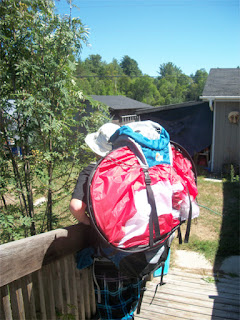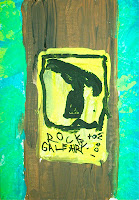09 Apr Pt 4: How To Make Room For Autism In Your Canoe – Practice Portaging & Gear
Dig this: April 2nd is World Autism Awareness Day (WAAD) and April is also known to many as Autism Awareness Month. This multiple part story/part guide, written in honour of The Six Degree Project (Autism Awareness Celebrity Campaign) and WAAD, is the tale (with tips) of how we got to the end of the portage with our son. With hopes to help raise awareness about autism and the extra challenge it brings to lives of many families, including ours; we also hope this Making Room For Autism In Your Canoe “series” helps to inspire other families to get out there and live their dreams as best as they are able – because even though, with autism, our lives are different – they shouldn’t be less. ~Fiona
|
Practicing for the portage at home.
|
Portaging at Home:
Just like practicing in the canoe, we also had to practice carrying packs around. Makobe is not always happy to carry things in his hands or have weight on his back, so this was a skill we needed to make sure he was able to partake in without much complaint before we expected him to pull it off on the trail after a long day of physical demands. Starting with lighter packs, Makobe would practice carrying gear on some of our walks and around our backyard trail. In the photo above, Makobe is carrying small pack filled with some gear for a day trip and our Wind Paddle for sailing in the canoe.
Appropriate Gear Makes For An Appropriate Experience:
It is very important to bring proper rain gear for everyone on a canoe trip, but it is especially wise to invest in a good breathable waterproof outerwear for any child or person with sensory sensitivities like those found with an autism diagnosis. Some people with autism are more sensitive to their environment and temperatures while others may not be able to communicate that they are feeling chilly. Sometimes a weather system can come in and catch you by surprise – things can get soaking wet and people can get cold really fast. Dressing in layers, including a fleece under a waterproof and breathable shell jacket/pants with waterproof boots can make for a very happy camper in wet conditions. The breathability factor is important as otherwise you really perspire, which can make you cold as well as your cloths remain damp from perspiration.
Bug coats are also a really good investment. Deet is not at all good for you and for people with a sensitive olfactory system, the mere smell of it can make for a horrible experience. Not to mention the fact that many people with autism have an oral fixation and like to put many things, including their own hands and sleeves, in their mouths. It is also a difficult concept to teach a delayed child not to breath in the bug spray if they can help it!
For our first family back country canoe trip, Makobe had a bug coat, a youth shell jacket and pants from MEC and a pair of CROCS boots (he has a thing for CROCS, what can we say?!). Please note: Tarps are also a must for shelter or wind blocker in harsh conditions or heavy downpours, and bug nets can also help during the bug season if the child expresses major discomfort and frustration over the biting and buzzing insects.
Coming next: Meltdowns & Communication in the Outdoors
To read all the parts to this story guide, click here: Making Room For Autism In Your Canoe
To read our report from Makobe’s first wilderness trip into Algonquin, please click here: Making Room For Autism In Your Canoe – A Trip Report
**Stim(s) or Stimming are the terms most used to describe a self-stimulatory behaviour or activity that is performed repetitively and usually to the alienation of others. Examples can be screaming, hand-flapping, finger play, rocking, spinning, lining up objects, verbal behaviour, etc.






Sorry, the comment form is closed at this time.